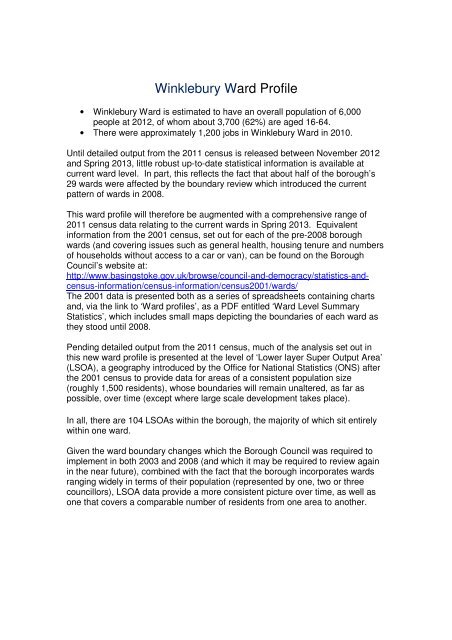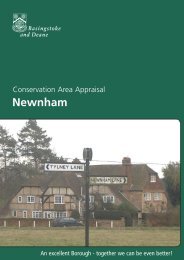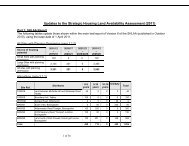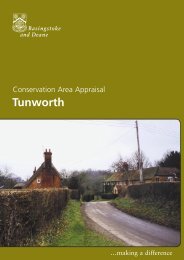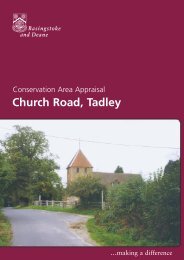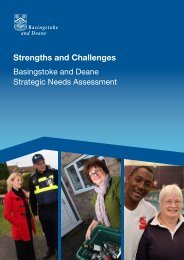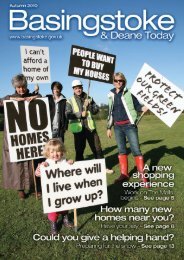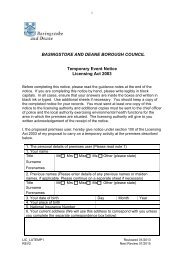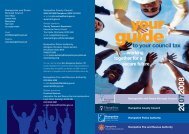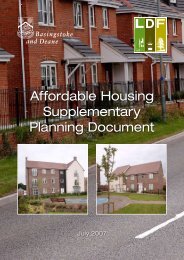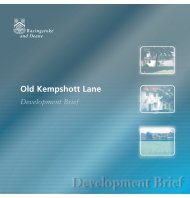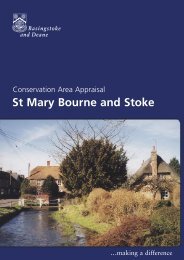Winklebury Ward Profile - Basingstoke and Deane Borough Council
Winklebury Ward Profile - Basingstoke and Deane Borough Council
Winklebury Ward Profile - Basingstoke and Deane Borough Council
You also want an ePaper? Increase the reach of your titles
YUMPU automatically turns print PDFs into web optimized ePapers that Google loves.
<strong>Winklebury</strong> <strong>Ward</strong> <strong>Profile</strong>• <strong>Winklebury</strong> <strong>Ward</strong> is estimated to have an overall population of 6,000people at 2012, of whom about 3,700 (62%) are aged 16-64.• There were approximately 1,200 jobs in <strong>Winklebury</strong> <strong>Ward</strong> in 2010.Until detailed output from the 2011 census is released between November 2012<strong>and</strong> Spring 2013, little robust up-to-date statistical information is available atcurrent ward level. In part, this reflects the fact that about half of the borough’s29 wards were affected by the boundary review which introduced the currentpattern of wards in 2008.This ward profile will therefore be augmented with a comprehensive range of2011 census data relating to the current wards in Spring 2013. Equivalentinformation from the 2001 census, set out for each of the pre-2008 boroughwards (<strong>and</strong> covering issues such as general health, housing tenure <strong>and</strong> numbersof households without access to a car or van), can be found on the <strong>Borough</strong><strong>Council</strong>’s website at:http://www.basingstoke.gov.uk/browse/council-<strong>and</strong>-democracy/statistics-<strong>and</strong>census-information/census-information/census2001/wards/The 2001 data is presented both as a series of spreadsheets containing charts<strong>and</strong>, via the link to ‘<strong>Ward</strong> profiles’, as a PDF entitled ‘<strong>Ward</strong> Level SummaryStatistics’, which includes small maps depicting the boundaries of each ward asthey stood until 2008.Pending detailed output from the 2011 census, much of the analysis set out inthis new ward profile is presented at the level of ‘Lower layer Super Output Area’(LSOA), a geography introduced by the Office for National Statistics (ONS) afterthe 2001 census to provide data for areas of a consistent population size(roughly 1,500 residents), whose boundaries will remain unaltered, as far aspossible, over time (except where large scale development takes place).In all, there are 104 LSOAs within the borough, the majority of which sit entirelywithin one ward.Given the ward boundary changes which the <strong>Borough</strong> <strong>Council</strong> was required toimplement in both 2003 <strong>and</strong> 2008 (<strong>and</strong> which it may be required to review againin the near future), combined with the fact that the borough incorporates wardsranging widely in terms of their population (represented by one, two or threecouncillors), LSOA data provide a more consistent picture over time, as well asone that covers a comparable number of residents from one area to another.
The geographical relationship between <strong>Winklebury</strong> <strong>Ward</strong> <strong>and</strong> its constituentLSOAs is illustrated in the map below.Age <strong>Profile</strong>:‘Small Area Population Forecasts’ (SAPF) are prepared annually by HampshireCounty <strong>Council</strong>, incorporating data on anticipated future rates of plannedresidential development, primarily within committed housing sites, over the nextseven years. SAPF provide one of the few contemporary datasets which areavailable at current ward level as well as LSOA level.Chart 1 has been prepared from 2011-based SAPF, illustrating the relationshipbetween the age profile of the residents of <strong>Winklebury</strong> <strong>Ward</strong> <strong>and</strong> that of theborough as a whole, both at 2012 <strong>and</strong> as forecast at 2018. The percentage ofthe ward population within each 5-year age group is shown in dark blue as at2012, <strong>and</strong> in light blue as forecast at 2018. Likewise, the borough population isshown in dark red at 2012 <strong>and</strong> in light red as forecast at 2018.
Chart 1: <strong>Ward</strong> Age <strong>Profile</strong>9%<strong>Winklebury</strong> <strong>Ward</strong>: 2012 & 2018Age profile in relation to boroughPercentage of population in each age group8%7%6%5%4%3%2%1%0%Aged0-4Aged5-9Aged Aged Aged Aged10-14 15-19 20-24 25-29Aged Aged Aged Aged Aged Aged30-34 35-39 40-44 45-49 50-54 55-59Aged Aged Aged Aged Aged Aged60-64 65-69 70-74 75-79 80-84 85+<strong>Winklebury</strong> 2012 5.8% 5.4% 6.0% 6.4% 5.5% 5.4% 5.3% 6.0% 7.2% 7.7% 6.7% 6.3% 7.0% 6.1% 4.1% 3.7% 3.0% 2.5%<strong>Basingstoke</strong> & <strong>Deane</strong> 2012 6.8% 6.1% 6.0% 6.0% 6.0% 6.4% 6.3% 6.7% 7.8% 7.9% 6.7% 5.8% 5.9% 4.9% 3.5% 2.8% 2.2% 2.2%<strong>Winklebury</strong> 2018 6.5% 5.6% 5.4% 5.7% 5.1% 5.9% 5.7% 5.2% 5.7% 6.7% 7.6% 7.4% 5.5% 5.7% 5.3% 4.0% 3.8% 3.1%<strong>Basingstoke</strong> & <strong>Deane</strong> 2018 6.8% 6.4% 6.0% 5.4% 5.5% 6.5% 6.8% 6.4% 6.4% 7.1% 7.2% 6.4% 5.2% 5.0% 4.6% 3.1% 2.5% 2.8%Source: Hampshire County Environment Department's 2011 based Small Area Population ForecastsAge profiles have also been prepared for each of the LSOAs which fall within<strong>Winklebury</strong> <strong>Ward</strong>. Rather than the percentages used in the ward level graph,Chart 2 shows the actual number of residents within each 5-year age group at2012, which illustrates the overall population of each LSOA as well as the ageprofile within each area.
Chart 2: LSOA Age <strong>Profile</strong>s160<strong>Winklebury</strong> <strong>Ward</strong>: LSOA age profiles 2012Number of residents in each age group14012010080604020B&D 010BB&D 010CB&D 010DB&D 010EB&D 013E0Aged0-4Aged5-9Aged10-14Aged15-19Aged20-24Aged25-29Aged30-34Aged35-39Aged40-44Aged45-49Aged50-54Aged55-59Aged60-64Aged65-69Aged70-74Aged75-79Aged80-84Aged85+Source: Hampshire County Environment Department's 2011 based Small Area Population ForecastsChart 3 shows the extent to which the overall population of each LSOA haschanged since the 2001 census, <strong>and</strong> the extent to which it is forecast to change(on the basis of current trends <strong>and</strong> committed housing development) by 2018.
Chart 3: Population Change<strong>Winklebury</strong> <strong>Ward</strong>: 2001-2018Forecast population change by LSOA0 200 400 600 800 1,000 1,200 1,400 1,600 1,800B&D 010B1,3041,2271,209B&D 010C1,3481,2911,278B&D 010D1,5131,4241,396B&D 010E1,4511,4151,609B&D 013E1,3151,2251,270LSOA population 2001 LSOA population 2012 Forecast LSOA population 2018Source: 2001 Census; Hampshire County Environment Department's 2011 based Small Area Population ForecastsMosaic <strong>Profile</strong>:Experian’s ‘Mosaic Public Sector 2011’, has been used to provide a classificationof borough households at current ward <strong>and</strong> LSOA level (as well as other smallgeographical areas) according to their location, demographics, lifestyles <strong>and</strong>behaviours.Mosaic profiles combine the latest available census data (currently from 2001,but taking account of key demographic changes since 2001) with annuallyupdated lifestyle/expenditure data (from a combination of sources includingExperian’s UK Consumer Dynamics Database) to help us underst<strong>and</strong> thecharacteristics of the households that live within each area. Experian categorisehouseholds into 69 Mosaic Types, which are aggregated into 15 Mosaic Groups.Chart 4 illustrates the percentage of households living in <strong>Winklebury</strong> <strong>Ward</strong> whichfall within each of the 15 Mosaic Groups. More detailed profiles could beproduced by ‘drilling down’, either to a finer grained ward level using the 69Mosaic Types, <strong>and</strong>/or to a smaller geographical area focusing on each LSOA (orsmaller area) in turn.
Chart 4: Mosaic <strong>Profile</strong><strong>Winklebury</strong> <strong>Ward</strong>: Mosaic profile 20110.2%1.0%1.6%2.1%B4.8%10.5%DK6.2%17.1%A: Residents of more isolated ruralcommunitiesB: Residents of small <strong>and</strong> mid-sized townswith strong local rootsC: Wealthy people living in the most soughtafterneighbourhoodsD: Successful professionals living insuburban or semi-rural homesE: Middle income families living in moderatesuburban semisF: Couples with young children incomfortable modern housingG: Young, well-educated urban dwellers25.0%J12.0%H2.1%Source: Mosaic Public Sector 2011 (Household-level), Experian14.2%E2.3%0.8%H: Couples <strong>and</strong> young singles in smallmodern starter homesI: Lower income workers in urban terracesin often diverse areasJ: Owner occupiers in older housing,typically in ex-industrial areasK: Residents with sufficient incomes in rightto-buysocial housingL: Active elderly people living in pleasantretirement locationsM: Elderly people reliant on state supportN: Young people renting flats in high densitysocial housingO: Families in low-rise social housing withhigh levels of benefit need
Indices of Deprivation:The English Indices of Deprivation (ID) are produced at LSOA level by the SocialDisadvantage Research Centre at the Department of Social Policy <strong>and</strong> SocialWork at the University of Oxford on behalf of the Department of Communities<strong>and</strong> Local Government (CLG). The most recently published indices are ID 2010,released in Spring 2011. However, it is acknowledged that due to issues of dataavailability at the time of index construction, most of the data in the 38 indicatorsused to compile ID 2010 relates to 2008.As well as an overall Index of Multiple Deprivation (IMD), ID 2010 provide seven‘domain’ indicators, covering:• Income;• Employment;• Health & Disability;• Education, Skills & Training;• Barriers to Housing & Services;• Crime; <strong>and</strong>• Living EnvironmentTwo additional indices are also provided:• Income Deprivation Affecting Children Index (IDACI); <strong>and</strong>• Income Deprivation Affecting Older People Index (IDAOPI)The only measure on which most of the LSOAs in many of the rural parts of theborough tend to fall within the 50% most deprived LSOAs in Engl<strong>and</strong> is ‘Barriersto Housing & Services’. This reflects the relatively high house prices in relationto income in the borough (in the national context), combined with the distance tocertain facilities such as food outlets, post offices, primary schools <strong>and</strong> doctors’surgeries.Chart 5 illustrates how each of the five LSOAs within <strong>Winklebury</strong> <strong>Ward</strong> is rankedunder the IMD, each of the domains, <strong>and</strong> both IDACI <strong>and</strong> IDAOPI, compared withall 32,482 LSOAs in Engl<strong>and</strong>. The closer each LSOA is to 100 on eachmeasure, the lower is the level of deprivation in the national context.
Chart 5: Indices of Deprivation<strong>Winklebury</strong> <strong>Ward</strong>: Indices of Deprivation 2010Income Deprivation AffectingOlder People Index (IDAOPI)Income Deprivation AffectingChildren Index (IDACI)Index of Multiple Deprivation20101009080706050403020100IncomeEmploymentLiving EnvironmentHealth & DisabilityB&D 010BB&D 010CB&D 010DB&D 010EB&D 013ECrimeBarriers to Housing & ServicesEducation Skills & TrainingSource: Indices of Deprivation 2010, DCLGMore detailed <strong>and</strong> more recent data covering some of the indicators used incertain domains of the ID 2010 can be found elsewhere, either in subsequentsections of this ward profile (for issues such as education) or in other documents,such as the Strategic Assessment produced annually by the <strong>Basingstoke</strong> <strong>and</strong><strong>Deane</strong> Community Safety Partnership on crime related issues.
Citizens Advice Bureau issues:Analysis of the issues raised by residents of each ward within the borough overthe past financial year at the two Citizen’s Advice Bureaux (CAB) based withinthe borough at <strong>Basingstoke</strong> <strong>and</strong> Tadley (together with those from the ‘WhitchurchProject’ based at Andover CAB) provides a good indication of the extent to whichdifferent issues impact on the residents of the various wards.It is acknowledged that some residents of the borough may take issues to otherCABs outside the borough, just as some of the issues h<strong>and</strong>led by Bureaux in theborough are brought by those living outside the borough.For the purpose of this analysis, data covering only the six most commonlyraised issues has been analysed in Chart 6, which shows the pattern of issuesraised in each ward throughout the borough. Clients are counted once onlyunder each issue, but a client may appear under more than one issue.Chart 6: Citizens Advice Bureau issuesPercentage of population making CAB enquiries on six major issues: 2011-120% 2% 4% 6% 8% 10% 12% 14%<strong>Borough</strong> averageBasingBaughurst <strong>and</strong> Tadley NorthBramley <strong>and</strong> SherfieldBrighton Hill NorthBrighton Hill SouthBrookvale <strong>and</strong> Kings FurlongBuckskinBurghclere, Highclere <strong>and</strong> St Mary BourneChinehamEastropEast WoodhayGroveHatch Warren <strong>and</strong> BeggarwoodKempshottKingsclereNordenOakley <strong>and</strong> North WalthamOverton, Laverstoke <strong>and</strong> SteventonPamber <strong>and</strong> SilchesterPopley EastPopley WestRooksdownSherborne St JohnSouth HamTadley CentralTadley SouthUpton Grey <strong>and</strong> The C<strong>and</strong>oversWhitchurch<strong>Winklebury</strong>BenefitsDebtEmploymentRelationshipHousingLegalSource: CAB data from <strong>Basingstoke</strong> & Tadley Bureaux + Whitchurch Project from Andover BureauChart 6 shows that whilst the percentage of each ward population presenting witha specific issue varies considerably, the pattern of relative frequency with whicheach issue has been raised within each ward is very similar, with benefit issuesbeing the most prolific.
Dwelling stock:Until detailed classification of the local dwelling stock by type, tenure <strong>and</strong> numberof rooms becomes available from the 2011 census over the coming winter, it isconsidered that the number of dwellings in each <strong>Council</strong> Tax b<strong>and</strong>, which isavailable as at 2011, currently provides the most useful indication of the patternof housing stock in each area.As each LSOA would have contained a similar number of dwellings whenestablished (as recorded at the 2001 census), the overall volume of housingstock at 2011 shown in Chart 7 also provides an indication of those LSOAswhere additional development occurred over the past decade.Chart 7: Dwelling Stock by <strong>Council</strong> Tax B<strong>and</strong> 2011<strong>Winklebury</strong> <strong>Ward</strong>: LSOA dwelling stock by <strong>Council</strong> Tax B<strong>and</strong> 20110 100 200 300 400 500 600 700B&D 010BB&D 010CB<strong>and</strong> AB<strong>and</strong> BB<strong>and</strong> CB<strong>and</strong> DB<strong>and</strong> EB<strong>and</strong> FB<strong>and</strong> GB<strong>and</strong> HB&D 010DB&D 010EB&D 013ESource: Valuation Office Agency (VOA)
Benefit claimants:Chart 8 sets out the number of claimants under each main benefits category at2010 within each LSOA in <strong>Winklebury</strong> <strong>Ward</strong>.Chart 8: Benefits Data140<strong>Winklebury</strong> <strong>Ward</strong>: 2010Benefits data: number of claimantsNumber of claimants in each LSOA120100806040Disability Living Allowance ClaimantsIncapacity Benefit/ Severe Disablement Allowance ClaimantsIncome Support ClaimantsJobseekers Allowance ClaimantsPension Credit Claimants200B&D 010B B&D 010C B&D 010D B&D 010E B&D 013ESource: Benefits Data: Summary Statistics, DWP, August 2010Chart 8 shows higher levels of people claiming Disability Living Allowance (DLA)<strong>and</strong> Incapacity Benefits/Severe Disablement Allowance. Levels of Job SeekersAllowance <strong>and</strong> Income Support claimants tend to be lower.Unemployment:Jobseekers’ Allowance (JSA) data provides the only source of unemploymentdata at the very local level below borough level. Chart 9 shows how the JSAcount has varied within each LSOA in <strong>Winklebury</strong> <strong>Ward</strong> between 2005 <strong>and</strong> 2012.
Chart 9: Jobseekers’ Allowance (JSA) claimantsNumber of JSA claimants in each LSOA5045403530252015105<strong>Winklebury</strong> <strong>Ward</strong>JSA Claimant Count by LSOA 2005-20120May 2005 May 2006 May 2007 May 2008 May 2009 May 2010 May 2011 May 2012B&D 010B 10 7 14 8 21 21 22 16B&D 010C 15 15 7 13 31 39 24 27B&D 010D 12 18 28 21 35 43 32 29B&D 010E 6 12 12 7 23 25 19 18B&D 013E 11 12 10 9 19 17 16 8Source: ONS Claimant Count , nomisChart 9 clearly shows the increase in JSA levels within all LSOAs in the ward in2008 <strong>and</strong> 2009 <strong>and</strong> an increase overall in the ward since 2005.Education:In line with the Indices of Deprivation, the indicator used to measure educationalattainment at Key Stage 2 (KS2) is based on the average points score achievedby pupils living in each LSOA.Likewise, in Key Stage 4 (KS4), the indicator is based on the average cappedpoints scores (which are based on the best eight results of each pupil) achievedby pupils living in each LSOA.The following attainment data is more up to date than that used in IoD 2010,reflecting the results achieved in 2011, when the borough average exceeded theEngl<strong>and</strong> average at KS2, but not at KS4.
Chart 10: Education – Key Stage 2 Assessment32<strong>Winklebury</strong> <strong>Ward</strong>: 2011Average Point Score of Pupils Eligible for KS2 Assessment302827.927.22728.2 28.227.52625.724222018B&D 010B B&D 010C B&D 010D B&D 010E B&D 013E <strong>Borough</strong> Engl<strong>and</strong>Source: National Curriculum Assessments at Key Stage 2 by Location of Pupil Residence, DfE, 2011Chart 11: Education – Key Stage 4 Assessment420400380<strong>Winklebury</strong> <strong>Ward</strong>: 2011Average Capped GCSE <strong>and</strong> Equivalent Point Score Per Pupilat the End of KS4360340320330.6317.5332.6326.6338.8300297280277.8260240220200B&D 010B B&D 010C B&D 010D B&D 010E B&D 013E <strong>Borough</strong> Engl<strong>and</strong>Source: GCSE <strong>and</strong> Equivalent Results for Young People by Pupil Residence, DfE, 2010/2011


